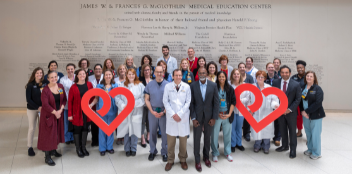EMS Responders Receive Device Training
As patients with LVADs and other mechanical assist devices become more prevalent, it’s essential that emergency responders receive proper training on how to respond to their medical emergencies. The Weil Institute of Emergency and Critical Care Research at VCU coordinated a daylong training session this fall on the American Heart Association’s Scientific Statement for resuscitating patients with the devices.
Dr. Mary Ann Peberdy, a cardiologist who directs VCU Health’s Advanced Resuscitation, Cooling Therapeutics and Intensive Care (ARCTIC) program, moderated the conference, held in September at the Henrico County Division of Fire’s training center. About 100 EMS providers from throughout central Virginia attended.
The program included lectures by Drs. Keyur Shah, Daniel Tang and Joseph Ornato. In the afternoon sessions, the participants went into different rooms, where they visited a mini-surgical suite and gained hands-on experience with the devices. In one room, they practiced taking an LVAD patient’s blood pressure with a Doppler device, one of the recommendations set out by the American Heart Association (AHA).
Peberdy was the writing group chair for the guidelines, known as the Scientific Statement by the American Heart Association on “Cardiopulmonary Resuscitation in Adults and Children with Mechanical Circulatory Support.” Ornato and Dr. Vigneshwar Kasirajan also helped write the statement, published in 2016.
Peberdy suggested the national recommendations … “The whole concept of how to resuscitate patients with mechanical circulatory support has been a long-standing issue,” she said.
Peberdy suggested the national recommendations as a member of the American Heart Association’s Scientific Committee. “The whole concept of how to resuscitate patients with mechanical circulatory support has been a long-standing issue,” she said. “Many times, EMS would get conflicting instructions from different hospitals on whether to do chest compressions on these patients or not when they were in cardiac arrest. They really needed a more standardized approach when they had to respond to these emergencies.”
One of the biggest surprises to the EMS providers is that many of the patients with the devices do not have a pulse, but rather a continuous flow of blood. Without proper training, a provider might assume the patient had undergone cardiac arrest if they are found unconscious. “But the lack of pulse alone doesn’t necessarily mean it was a cardiac arrest. The patient could have been unconscious because their blood sugar could be low, they could have had a stroke or many other reasons,” she said.
As a result, the statement includes two recommendations for determining if these patients are in cardiac arrest:
1) Check blood pressure with a Doppler instead of a standard blood pressure cuff
2) If a breathing tube is required, measure the breath emanating from the tube to determine if the heart is pumping adequately
Such clarity is critical. “More and more patients with these devices are discharged from the hospital and living in the community. There are more than a hundred in the Richmond area,” she said. “And from a national level, it is something of growing importance.”
Back to Spring-2019

